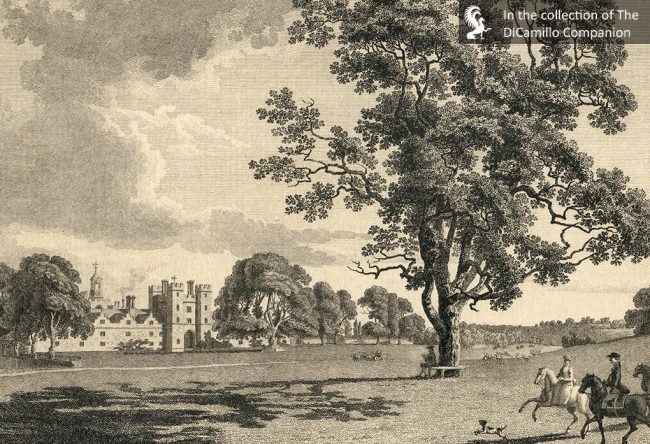
A 1778 engraving of the house from "The Copper Plate Magazine"

The entrance facade from the deer park

Coronet on entrance facade gate

The Stone Court from a circa 1912 postcard

The inner courtyard
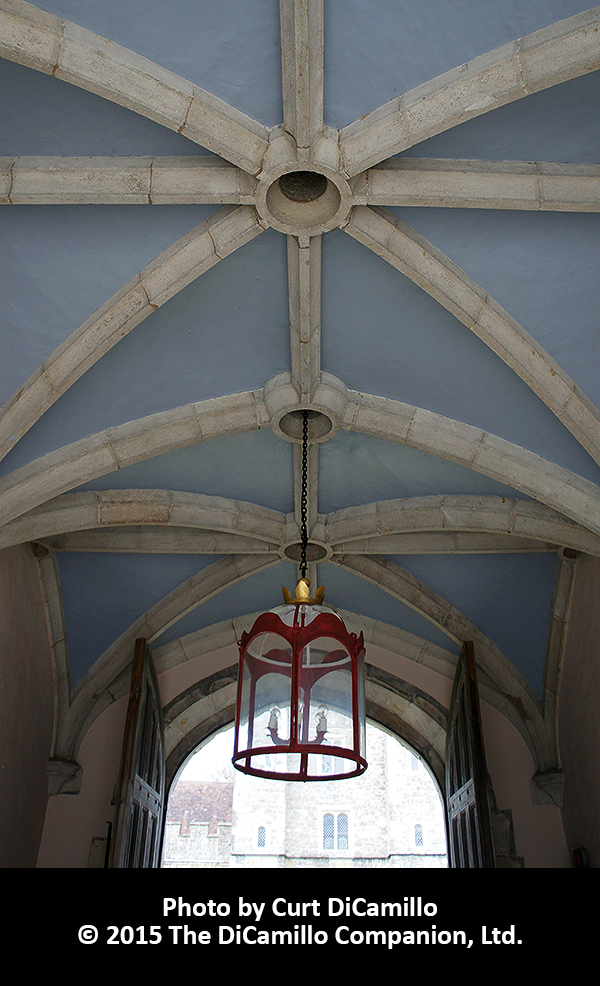
Courtyard entrance ceiling
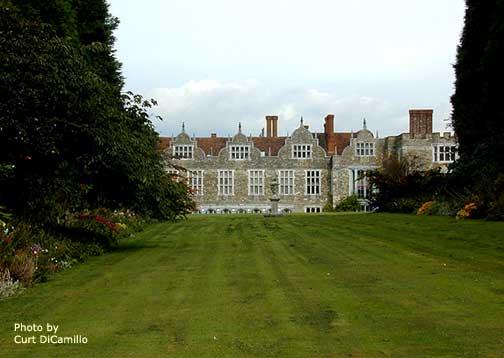
The south facade

The south facade from a circa 1912 postcard
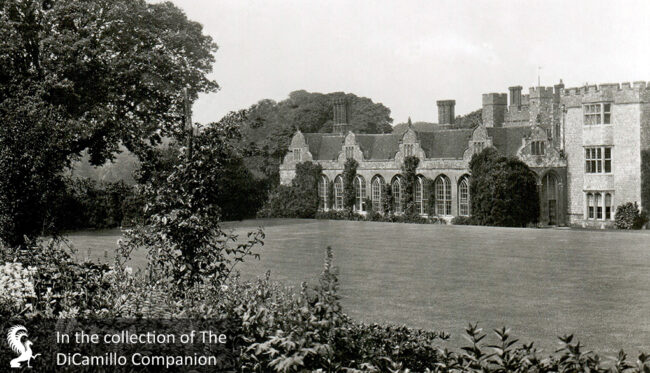
The orangery from a circa 1912 postcard
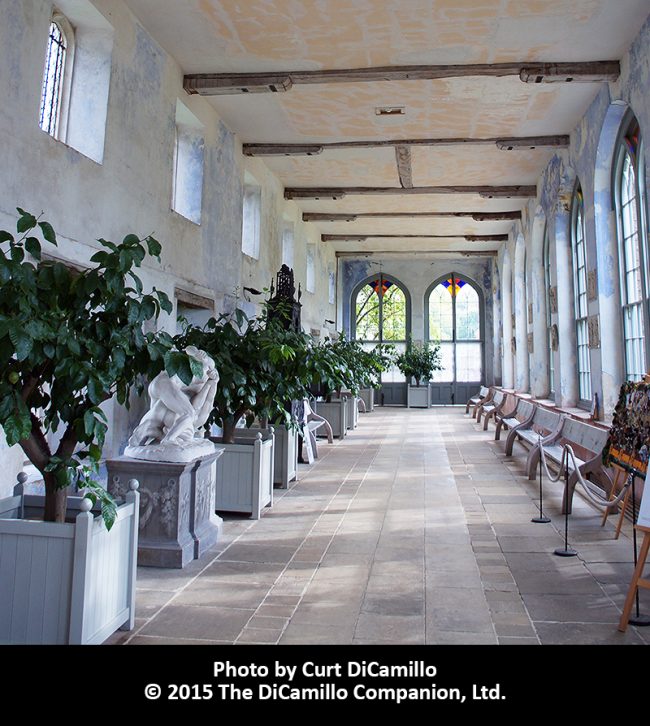
Interior of the orangery in 2015
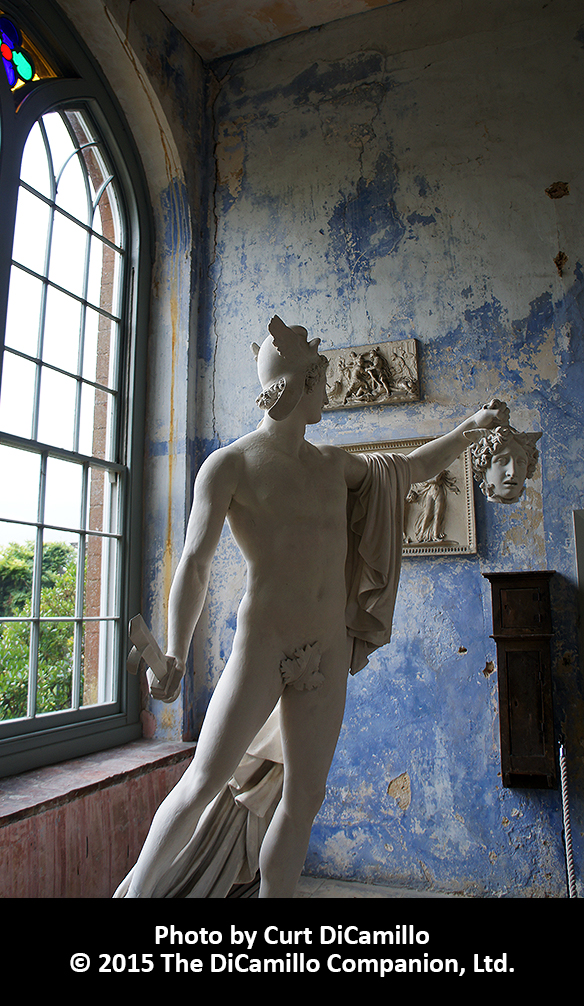
Interior of the orangery in 2015

The ballroom from a circa 1912 postcard
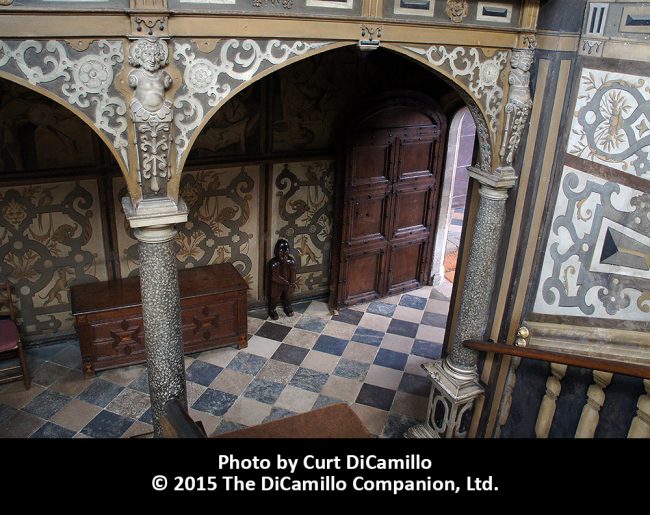
The staircase
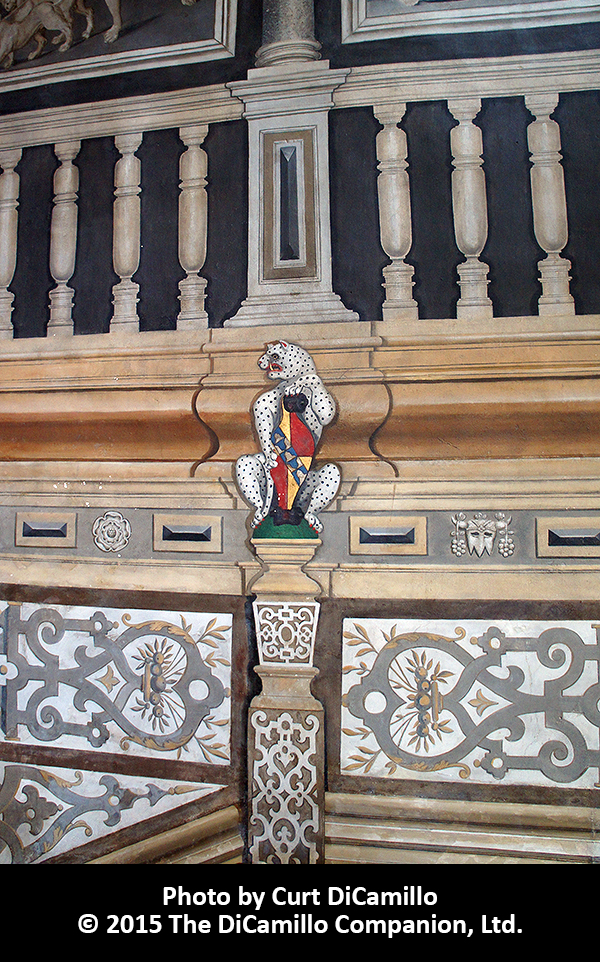
Painted staircase wall
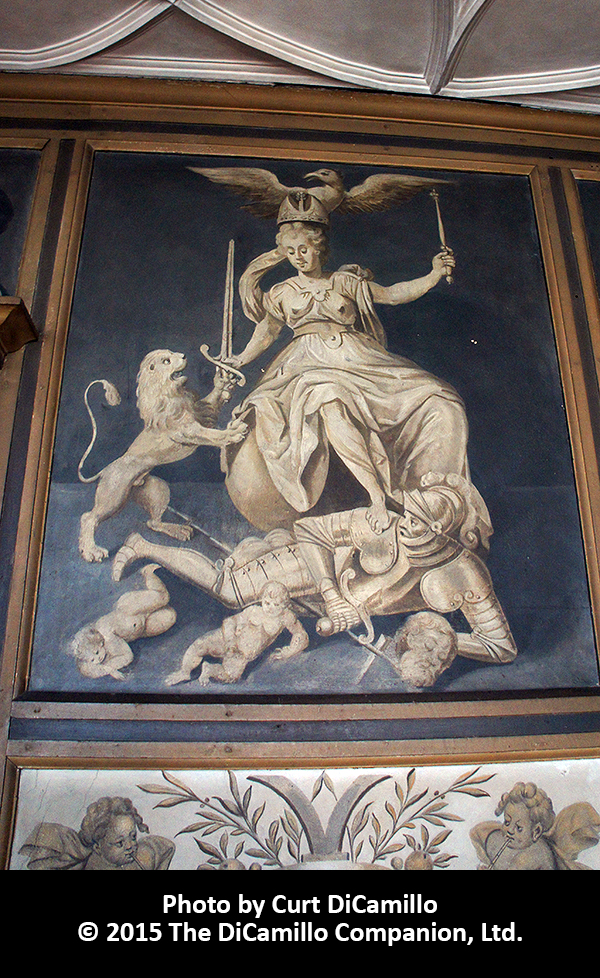
Painted wall
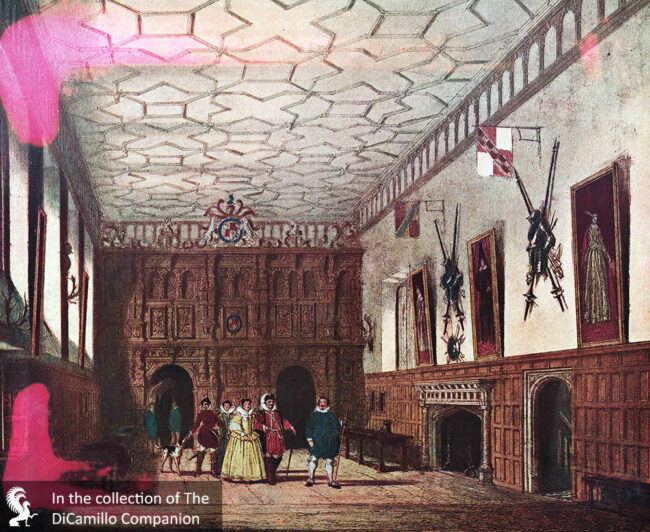
A late 19th century lithograph of the entrance hall from Joseph Nash's "Interiors of Old English Mansions"
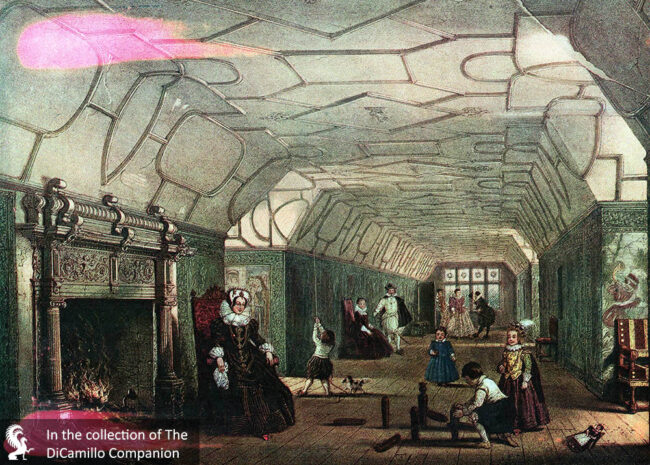
A late 19th century lithograph of the gallery from Joseph Nash's "Interiors of Old English Mansions"

A late 19th century lithograph of the chapel ante room from Joseph Nash's "Interiors of Old English Mansions"

A late 19th century lithograph of a bedroom from Joseph Nash's "Interiors of Old English Mansions"
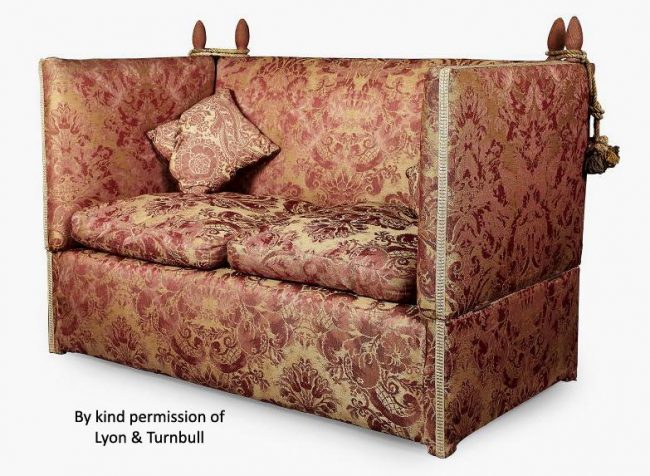
A 19th century Knole sofa that was auctioned at Lyon & Turnbull, Edinburgh, in 2014.
Earlier Houses: Earlier monastic buildings existed on the site of the current house.
Built / Designed For: Thomas Bourchier, Archbishop of Canterbury
House & Family History: Knole was built from 1456 to 1486 by Thomas Bourchier, Archbishop of Canterbury, who purchased the land and existing buildings from Lord Saye and Sele. The house was seized by Henry VIII during the Dissolution of the Monasteries and enlarged significantly by him. Knole was the gift of Elizabeth I to the Earl of Leicester in 1561; after his death she gifted the estate to her cousin, Thomas Sackville, 1st Earl of Dorset, who eventually purchased Knole outright in 1603. Between 1603 and 1608 the earl remodeled, enlarged, and embellished the house; his alterations left Knole as it is seen today—an English Renaissance palace. Easily among the highlights of the 1st Earl's work is the ballroom, one of the most important and complete examples of early Jacobean interior decoration in Britain. Beginning in 1604, the ballroom was transformed by Richard Dungan, the king's plasterer, and William Portington, the king's carpenter, who together created the extraordinary plasterwork ceiling, carved frieze, and oak paneling. The grand chimneypiece and overmantel are the work of Cornelius Cure, master mason to the crown, and rank among the finest works of Renaissance sculpture in Britain. Most of the contents were lost during the Civil War, but many fine pieces of art were acquired by the 6th Earl of Dorset through his position as lord chamberlain to William III; the 6th Earl's acquisitions left the 13 state rooms lavishly furnished and much as seen today. Knole has been home to the Sackville family since 1603, including the earls of Dorset and four dukes of Dorset. The Sackvilles were a famous literary family and hosted many authors at Knole, including Alexander Pope, John Dryden, and Matthew Prior. Knole was the birthplace of writer Vita Sackville-West (the only child of the 3rd Lord Sackville and author of "Knole and the Sackvilles," published in 1922) and was featured in Virginia Woolf's novel "Orlando," the main character of which was modeled on Vita. The 4th Lord Sackville donated the house, together with 52 acres, to the National Trust in 1946. Knole is the largest private house in England (its footprint covers four acres) and is a calendar house: it contains 365 rooms, 52 staircases, and seven courtyards. The estate takes its name from a knoll, or rounded hill.
Collections: Knole contains the world's pre-eminent collection of 17th century English furniture and tapestries (because of the 6th Earl of Dorset's collecting). There are fine collections of portraits, textiles, and porcelain, as well as paintings by van Dyck, Kneller, Reynolds, and Gainsborough. The Cartoon Gallery contains six large copies of Raphael's cartoons, said to have been presented by Charles I to Lionel Cranfield, the 1st Earl of Middlesex. They were at Cranfield's seat, Copt Hall in Essex, until 1701, when Copt Hall was sold to the 6th Earl of Dorset. The King's Room contains the famous and very rare collection of English silver furniture, made between 1680 and 1681 in London. The Spangle Dressing Room has a harpsichord case that is dated 1622 and signed by the London maker John Hassard; its dating makes it the second-earliest known English harpsichord. John Frederick Sackville, 3rd Duke of Dorset, famously commissioned a reclining nude sculpture of his mistress, the dancer Giannetta Baccelli, which is still at Knole today. The famous Knole Sofa (also known as the Knole Settee) is a 17th century sofa named after the house where it lives. Its original use was not as a comfortable sofa in the modern sense, but as a formal throne on which the monarch would sit to receive visitors. The design later became very popular and thousands of reproductions were made; mention of a Knole sofa even appears frequently in literature. The sofa is notable for its side arms, which are the same height as the back of the sofa and are often adjustable. The side arms are tied to the sofa by heavy decorative braid, usually with an elaborate tassel, and there are wooden finials at the rear corner tops. See a photo of a 19th century Knole sofa in "Images" section. A 16th century Flemish tapestry of the miracles of Saint Claude (now called "The Just Verdict of Trajan"), originally at Knole, was purchased in 1916 by Bostonian George Robert White when some of the collection of J. Pierpont Morgan was dispersed. Today the tapestry is in the collection of the Museum of Fine Arts, Boston (J.P. Morgan had purchased a number of medieval tapestries from Knole for £65,000 in the 19th century). There is a fine portrait (watercolor on vellum) of Richard Sackville, 3rd Earl of Dorset, by Isaac Oliver in the collection of the Victoria & Albert Museum, London. John Wootton's "Dover Castle" was sold in 1988 for £142,707, to remain onsite.
Comments: Knole is considered one of the greatest and most important houses of England.
Garden & Outbuildings: Spanning 1,000 acres, Knole is set in the only remaining Medieval deer park in Kent. Within the park is the birdhouse, a black and white octagonal cottage-folly, built in in the Gothick style in 1761. The conical-roofed folly (privately tenanted) is famous today as the site of one of the first-everorangery, which also serves as a sculpture gallery, was created in 1823 using elements of earlier buildings.
Architect: John Thorpe
Date: 1603-08Architect: William Kent
Date: Circa 1730Vitruvius Britannicus: C. IVth pls. 34, 35, 1739.
John Preston (J.P.) Neale, published under the title of Views of the Seats of Noblemen and Gentlemen in England, Wales, Scotland, and Ireland, among other titles: Vol. II, 1819.
Country Life: XXXI, 772 plan, 796 [Furniture], 826 plan, 862, 1912. XCVII, 72 [Furniture], 1945. CI, 660, 1947. CXXXVIII, 1252 [Lead Roof], 1965. CLXI, 1495 [Furniture], 1620 [Furniture], 1977.
Title: Follies: Fabulous, Fanciful and Frivolous Buildings
Author: Headley, Gwen
Year Published: 2012
Reference: pg. 47
Publisher: London: The National Trust
ISBN: 9781907892301
Book Type: Hardback
Title: National Geographic (magazine)
Author: NA
Year Published: NA
Reference: Nov 1985, pg. 674
Publisher: Washington, DC: National Geographic Society
ISBN: 00279358
Book Type: Magazine
Title: Museum of Fine Arts, Boston: A Centennial History, Volume One
Author: Whitehill, Walter Muir
Year Published: 1970
Reference: pg. 420
Publisher: Cambridge, MA: Harvard University Press
ISBN: 674588754
Book Type: Hardback
Title: V&A Guide to Period Styles: 400 Years of British Art and Design, The
Author: Jackson, Anna; Hinton, Morna
Year Published: 2002
Reference: pg. 21
Publisher: London: V&A Publications
ISBN: 0810965909
Book Type: Hardback
Title: Disintegration of a Heritage: Country Houses and their Collections, 1979-1992, The
Author: Sayer, Michael
Year Published: 1993
Publisher: Norfolk: Michael Russell (Publishing)
ISBN: 0859551970
Book Type: Hardback
House Listed: Grade I
Park Listed: Grade I
Current Seat / Home of: Robert Bertrand Sackville-West, 7th Baron Sackville; Sackville family here since 1603.
Past Seat / Home of: Richard Fiennes, de jure 4th Baron Saye and Sele, 15th century. Thomas Bourchier, Archbishop of Canterbury, 15th century. King Henry VIII, 16th century. Robert Dudley, 1st Earl of Leicester, 1561-88. Thomas Sackville, 1st Earl of Dorset, circa 1588-1608; Robert Sackville, 2nd Earl of Dorset, 1608-09; Richard Sackville, 3rd Earl of Dorset, 1609-24; Edward Sackville, 4th Earl of Dorset, 1624-52; Richard Sackville, 5th Earl of Dorset, 1652-77; Charles Sackville, 6th Earl of Dorset, 1677-1706; Lionel Cranfield Sackville, 1st Duke of Dorset and 7th Earl of Dorset, 1706-65; Charles Sackville, 2nd Duke of Dorset, 1765-69; John Frederick Sackville, 3rd Duke of Dorset, 1769-99; George John Frederick Sackville, 4th Duke of Dorset, 1799-1815; Charles Sackville-Germain, 5th Duke of Dorset, 1815-43; Mortimer Sackville-West, 1st Baron Sackville, 1843-88; Lionel Sackville-West, 2nd Baron Sackville, 1888-1908; Lionel Sackville-West, 3rd Baron Sackville. 1908-28; Major-General Charles John Sackville-West, 4th Baron Sackville, 1928-62; Edward Sackville-West, 5th Baron Sackville, 1962-65; Lionel Bertrand Sackville-West, 6th Baron Sackville, 1965-2004.
Current Ownership Type: The National Trust
Primary Current Ownership Use: Visitor Attraction
Ownership Details: The house is owned by the National Trust; the Sackville-West family, who reside in a wing, own the estate and the deer park.
House Open to Public: Yes
Phone: 01732-462-100
Fax: 01732-465-528
Email: [email protected]
Website: https://www.nationaltrust.org.uk
Historic Houses Member: No